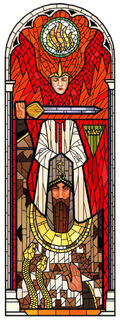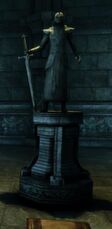(→Quotes) Tags: Visual edit apiedit |
(→Quotes) Tag: Visual edit |
||
| (8 intermediate revisions by 8 users not shown) | |||
| Line 9: | Line 9: | ||
|class = [[Mage]] |
|class = [[Mage]] |
||
|race = [[Human]] |
|race = [[Human]] |
||
| + | |family = Valerius <small>(father)</small> <br> [[Eleni Zinovia]] <small>(mother)</small> <br> [[Vasilia]] <small>(wife)</small> |
||
|voice = [http://www.imdb.com/name/nm0811875/ David Sobolov] |
|voice = [http://www.imdb.com/name/nm0811875/ David Sobolov] |
||
|appearances = [[Dragon Age: Origins]] |
|appearances = [[Dragon Age: Origins]] |
||
| Line 16: | Line 17: | ||
== Background == |
== Background == |
||
| − | [[File:Hessarian andraste.jpg|thumb|120px|Stained glass depicting Hessarian's merciful killing of Andraste.<ref>{{Cite wot|123}}</ref>]] |
+ | [[File:Hessarian andraste.jpg|thumb|120px|Stained glass depicting Hessarian's merciful killing of Andraste.<ref name="wot123">{{Cite wot|123}}</ref>]] |
| − | [[Maferath]], the mortal husband of Andraste, betrayed the [[Alamarri]] warrior-prophet to the Imperium. With Andraste in captivity, the Archon decided her fate, encouraged by his wife [[Vasilia|Lady Vasilia]] to be ruthless |
+ | [[Maferath]], the mortal husband of Andraste, betrayed the [[Alamarri]] warrior-prophet to the Imperium. With Andraste in captivity, the Archon decided her fate, encouraged by his wife [[Vasilia|Lady Vasilia]] to be ruthless though he originally wanted a quick death for Andraste. In a square in the capital [[Minrathous]], Andraste was burned alive before a crowd of her adherents and enemies alike as an example to all those who challenged the Imperium, but showed no distress in her death. It is said that in the prophetess' final moments, the [[Maker]] spoke to Hessarian, filling him with guilt and compassion and so he drove [[Codex entry: Blade of Mercy|his sword]] through her heart to put an end to her suffering. |
| − | Ten years to the day after Andraste's death, the Archon converted to the Chant of Light, claiming that he heard the voice of the Maker when his blade touched Andraste, and the beginnings of the religion took root. He declared the Maker the one true god and publicly revealed Maferath's betrayal. Most of the high-ranking clergy, including nearly all of the ruling Altus magisters, refused to give up their Old Gods, but the non-mage Soporati class overwhelmingly supported Hessarian, beginning a period known as the Transfiguration. With the High Priests dead, Hessarian repurposed the Old God temples into the first [[Circle of Magi]].<ref |
+ | Though Hessarian had originally intended to end Andraste's following, he refused to take action against them following her death.<ref name="wot2">{{Cite wot2|39}}</ref> Ten years to the day after Andraste's death, the Archon converted to the Chant of Light, claiming that he heard the voice of the Maker when his blade touched Andraste, and the beginnings of the religion took root. He declared the Maker the one true god, made Andrastianism the religion of the Imperium, and publicly revealed Maferath's betrayal. Most of the high-ranking clergy, including nearly all of the ruling Altus magisters, refused to give up their Old Gods, but the non-mage Soporati class overwhelmingly supported Hessarian, beginning a period known as the Transfiguration. With the High Priests dead, Hessarian repurposed the Old God temples into the first [[Circle of Magi]].<ref name="wot123" /> There is apparently debate as to whether he was sincere in his conversion, with some suggesting that he simply found it politically expedient to embrace a religion which was already gaining popularity amongst his own people. However, his ghost/shade claimed to truly have felt pity for Andraste, feeling it was his duty as a true ruler to show mercy and that he hoped for mercy to be shown to him. |
Archon Hessarian's act of clemency is a very influential tale in the Chantry, and his sword, covered in the flame of Andraste's pyre, is a well-recognized icon of the [[The Templar Order|Templar Order]]. Being the [[Imperial Chantry]] founder, he is especially revered in Tevinter, where he is considered the most important of [[Disciples of Andraste|Andraste's disciples]] and the anniversary of his death is a religious holiday.<ref name="wot125">{{Cite wot|125}}</ref> |
Archon Hessarian's act of clemency is a very influential tale in the Chantry, and his sword, covered in the flame of Andraste's pyre, is a well-recognized icon of the [[The Templar Order|Templar Order]]. Being the [[Imperial Chantry]] founder, he is especially revered in Tevinter, where he is considered the most important of [[Disciples of Andraste|Andraste's disciples]] and the anniversary of his death is a religious holiday.<ref name="wot125">{{Cite wot|125}}</ref> |
||
| + | |||
| + | After a long and tumultuous rule and life, Hessarian died in his sleep in -125 Ancient.<ref>{{Cite wot|49}}</ref> |
||
== Involvement == |
== Involvement == |
||
| Line 29: | Line 32: | ||
== Quotes == |
== Quotes == |
||
| − | * "Yes. I could not bear the sight of Andraste |
+ | * "Yes. I could not bear the sight of Andraste's suffering, and mercy bade me end her life. I am the penitent sinner, who shows compassion as he hopes compassion will be shown to him." |
== See also == |
== See also == |
||
| Line 36: | Line 39: | ||
== Trivia == |
== Trivia == |
||
* In a dialogue between [[Isabela]] and [[Bethany Hawke|Bethany]] it is mentioned that there is a pornography book named "''Hessarian's Spear''," involving him and [[Andraste]]. |
* In a dialogue between [[Isabela]] and [[Bethany Hawke|Bethany]] it is mentioned that there is a pornography book named "''Hessarian's Spear''," involving him and [[Andraste]]. |
||
| + | * Hessarian wrote the Canticles of Erudition and Penance, which are still sung in the Chantry today. His alternate version of Transfigurations, which removes references to prohibitions against magic, is only taught in the Imperial Chantry. His Canticle of Silence is part of the Dissonant Verses.<ref name="wot2" /> |
||
| + | * When encountered during the trials he is equipped with [[The Summer Sword]]. |
||
== Gallery == |
== Gallery == |
||
| − | <gallery widths=230 captionalign="center"> |
+ | <gallery widths="230" captionalign="center"> |
| − | Archon Hessarian statue.png|Hessarian's statue in modern-day [[Tevinter Imperium]].<ref name="wot125"/> |
+ | Archon Hessarian statue.png|Hessarian's statue in modern-day [[Tevinter Imperium]].<ref name="wot125" /> |
Archon Hessarian Statue.jpg|Hessarian's statue in the [[Ruined Temple]] operated by the [[Disciples of Andraste]]. |
Archon Hessarian Statue.jpg|Hessarian's statue in the [[Ruined Temple]] operated by the [[Disciples of Andraste]]. |
||
| + | Hessarian wotv2.jpg|Artwork of Hessarian from [[Dragon Age: The World of Thedas Volume 2]] |
||
</gallery> |
</gallery> |
||
== References == |
== References == |
||
| − | <references/> |
+ | <references />[[Category:Characters]] |
| − | [[Category:Characters]] |
||
[[Category:Historical characters]] |
[[Category:Historical characters]] |
||
[[Category:Humans]] |
[[Category:Humans]] |
||
Revision as of 20:31, 1 May 2018
“I am the penitent sinner who shows compassion in hope that compassion will be shown to him.”
Hessarian, also known as Hessarian the Redeemed[1], was the Archon of the Tevinter Imperium during the time of Andraste. He is a critical figure in Chantry lore for his role in ordering the prophet's death by fire. He was also the first to convert to the Chant of Light. An Ash Wraith with Hessarian's appearance is encountered in the The Gauntlet as part of the first trial in A Test of Faith, however it is not known if the shade came from Hessarian's immolation as a part of a ritual or not.
Background

Stained glass depicting Hessarian's merciful killing of Andraste.[2]
Maferath, the mortal husband of Andraste, betrayed the Alamarri warrior-prophet to the Imperium. With Andraste in captivity, the Archon decided her fate, encouraged by his wife Lady Vasilia to be ruthless though he originally wanted a quick death for Andraste. In a square in the capital Minrathous, Andraste was burned alive before a crowd of her adherents and enemies alike as an example to all those who challenged the Imperium, but showed no distress in her death. It is said that in the prophetess' final moments, the Maker spoke to Hessarian, filling him with guilt and compassion and so he drove his sword through her heart to put an end to her suffering.
Though Hessarian had originally intended to end Andraste's following, he refused to take action against them following her death.[3] Ten years to the day after Andraste's death, the Archon converted to the Chant of Light, claiming that he heard the voice of the Maker when his blade touched Andraste, and the beginnings of the religion took root. He declared the Maker the one true god, made Andrastianism the religion of the Imperium, and publicly revealed Maferath's betrayal. Most of the high-ranking clergy, including nearly all of the ruling Altus magisters, refused to give up their Old Gods, but the non-mage Soporati class overwhelmingly supported Hessarian, beginning a period known as the Transfiguration. With the High Priests dead, Hessarian repurposed the Old God temples into the first Circle of Magi.[2] There is apparently debate as to whether he was sincere in his conversion, with some suggesting that he simply found it politically expedient to embrace a religion which was already gaining popularity amongst his own people. However, his ghost/shade claimed to truly have felt pity for Andraste, feeling it was his duty as a true ruler to show mercy and that he hoped for mercy to be shown to him.
Archon Hessarian's act of clemency is a very influential tale in the Chantry, and his sword, covered in the flame of Andraste's pyre, is a well-recognized icon of the Templar Order. Being the Imperial Chantry founder, he is especially revered in Tevinter, where he is considered the most important of Andraste's disciples and the anniversary of his death is a religious holiday.[4]
After a long and tumultuous rule and life, Hessarian died in his sleep in -125 Ancient.[5]
Involvement
During A Test of Faith, the Warden will need to answer his riddle, "She wields the broken sword, and separates true kings from tyrants. Of what do I speak?" The answer is "Mercy."
If the Warden answers correctly the shade will disappear. If the Warden answers incorrectly, "Hessarian" will turn into an Ash Wraith and attack.
Quotes
- "Yes. I could not bear the sight of Andraste's suffering, and mercy bade me end her life. I am the penitent sinner, who shows compassion as he hopes compassion will be shown to him."
See also
![]() Codex entry: The Conversion of Hessarian
Codex entry: The Conversion of Hessarian
Trivia
- In a dialogue between Isabela and Bethany it is mentioned that there is a pornography book named "Hessarian's Spear," involving him and Andraste.
- Hessarian wrote the Canticles of Erudition and Penance, which are still sung in the Chantry today. His alternate version of Transfigurations, which removes references to prohibitions against magic, is only taught in the Imperial Chantry. His Canticle of Silence is part of the Dissonant Verses.[3]
- When encountered during the trials he is equipped with The Summer Sword.
Gallery
References
- ↑
 Dragon Age: The World of Thedas, vol. 1, p. 115
Dragon Age: The World of Thedas, vol. 1, p. 115
- ↑ 2.0 2.1
 Dragon Age: The World of Thedas, vol. 1, p. 123
Dragon Age: The World of Thedas, vol. 1, p. 123
- ↑ 3.0 3.1
 Dragon Age: The World of Thedas, vol. 2, p. 39
Dragon Age: The World of Thedas, vol. 2, p. 39
- ↑ 4.0 4.1
 Dragon Age: The World of Thedas, vol. 1, p. 125
Dragon Age: The World of Thedas, vol. 1, p. 125
- ↑
 Dragon Age: The World of Thedas, vol. 1, p. 49
Dragon Age: The World of Thedas, vol. 1, p. 49

![Archon Hessarian statue.png (309 KB) Hessarian's statue in modern-day Tevinter Imperium.[4]](https://static.wikia.nocookie.net/dragonage/images/2/24/Archon_Hessarian_statue.png/revision/latest/scale-to-width-down/121?cb=20131020130051)

